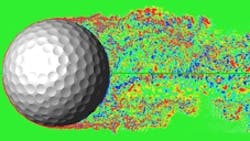Fly farther
This image shows the flow around a golf ball traveling at speeds up to 100 mph. The computations are among the largest direct numerical simulations of complex flows ever performed, involving billions of grid points. The aim is to pinpoint how dimples dramatically reduce the drag force on the golf ball. Although the United States Golf Association (USGA) regulates golf ball design, including size and weight, the dimple pattern is not standardized. Up to now, sporting goods companies would design dimple patterns by trial and error, testing prototypes against one another. The new study looks at how to design dimple size and pattern based on mathematical equations that model the physics of a golf ball in flight. The project is a collaboration between Dr. E. Balaras from the University of Maryland, Dr. K. Squires from Arizona State University, and Masaya Tsunoda of Sumitomo Rubber Industries.
